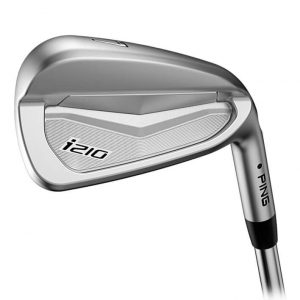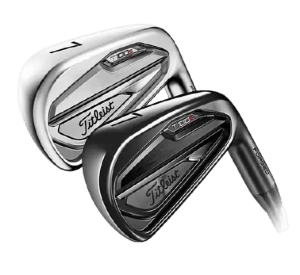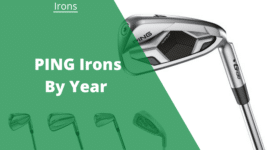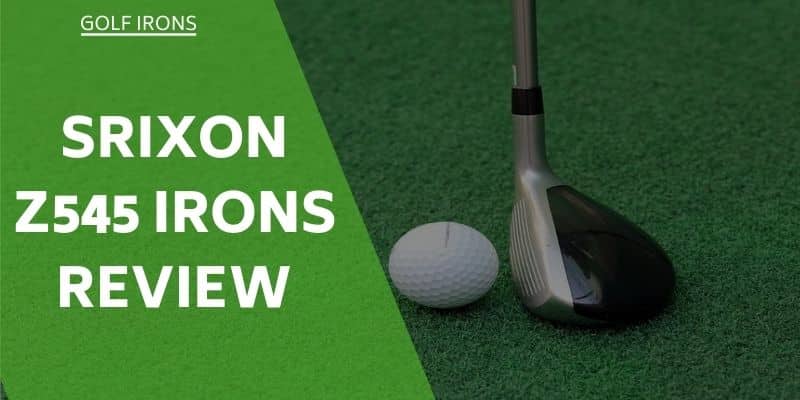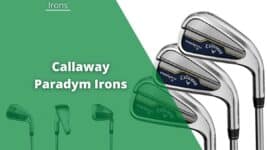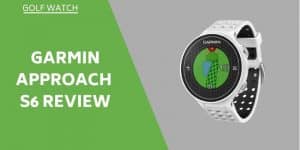Searching for the best cavity back irons to play in 2024 is an exciting and rewarding experience for golfers of all skill levels looking to improve their game.
In this article, we have researched the best buys for:
The low and accomplished golfer wanting to get the best out of their game.
The mid handicap player looking to improve their game.
The beginner and high handicap golfer wanting to improve their game and move to the next level.
It is true to say that irrespective of the competency of many golfers, the need to improve and get the most enjoyment out of the game is a driving factor.
Do Cavity Back Irons Really Help?
The introduction of cavity back irons has undoubtedly been one of the greatest game-changing innovations that this testing game has experienced.
Any golfer who started playing golf with blades can testify to the fact.
The sleek-looking blades with a small head only allowed for a tiny “sweet” spot in the center of the head.
Any mis-hits would create a “shudder” through the hands and wrist and the distance was greatly compromised.
Launching the long irons required many hours of practice and an above-average skill level.
Ping was the first to introduce the cavity back iron with the Ping Eye irons.
All the manufacturers moved to the cavity back technology to cater to the demand of the masses wanting to improve their all-round game.
Cavity-back irons have a large sweet spot on the face allowing for mis-hits that still travel straight and a fair distance.
This result is due to the weight distribution which is moved to the heel and toe of the clubhead.
Less sidespin is created off the face which produces reduced hooks and fades and moving the weight allows for the option to place it lower in the head and lowers the CG.
Lower CG means a club that is easily launched from all lies on the course.
Put all the benefits together and it is easy to understand why most golfers today choose to play cavity back irons in some form or another.
Do PGA Players Use Cavity Back Irons?
Tour players, whether in the senior ranks or mainstream tournaments earn their living by playing good golf and eliminating mistakes on the course.
Cavity back irons provide the same game improvement to these accomplished players and offer them more options depending on course and weather conditions.
On windy days the pros will opt for a cavity or muscle back long iron instead of launching a 5 wood high into the air.
The downside of a cavity back iron is that it produces less side spin which in turn makes it more difficult to hit a big hook or fade.
However, it is not uncommon to see a combination of cavity back and muscle back irons in the pros bag.
Many senior players on tour have to compensate for the lack of flexibility in their bodies and use the cavity back irons to good effect.
Distance with accuracy will always be a factor and cavity backs provide this.
An area where pros still rely heavily on blades is the short irons.
From an 8-iron to the various wedges in the bag, they want to control the spin, distance, and accuracy into the green.
They spend many, many hours practicing this aspect of the game to ensure confidence and scoring opportunities on the round.
Amateurs will be well advised to use cavity back irons through the set, with maybe the exception of the short irons and wedges.
Cavity Back Putters
Very few pros use a genuine blade putter on the tour. The cavity back putter has an increased sweet spot with the weight either evenly distributed in the head or a heel-toe weighting.
Slow greens, which are uncommon on the tour, or wet conditions allow the pros to opt for a slightly heavier putter.
Weight can be added or reduced on many of the top putters today and placed where best suited to the player.
The Best 3 Cavity Back Irons for Low Handicaps
1. Ping i210 Irons
Pros
- Precision milled for good looks and playability
- All the good technology from the i200 improved in the i210
- The larger improved elastomer in the sole
- Designed for the better player
Cons
- Ping looks at address, not for all
- Topline size
The i210 cavity, face, and grooves are precision milled to enhance looks and playability.
The i210 model has taken all the good things from the previous i200 model and improved them.
The cavity back design head features a larger section in the sole area.
A greater improved tuning port and softer elastomer insert that is 30 % larger fits into the sole area.
Players wanting a classic design iron with forgiveness will enjoy this set.
The i210 is designed for the better player who seeks ball flight control, rather than sheer distance.
A high-performing iron set that generates good ball speed off the machined face, creating distance, soft feel, and control.
The “muscle-back” compact look on the shorter irons with a smaller cavity and less offset will add appeal.
A refined leading edge glides through all turf conditions with ease.
Lofts on the standard set move from 19-degrees on the 3-iron to 41-degrees on the 9-iron, and 45-degrees on the pitching wedge.
Better players will appreciate the improvements in this set.
2. Titleist T100 Irons
Pros
- Most blade-like look
- Thin top-line
- Traditional look with forgiveness
- Premier iron that is easy to hit
- Minimal offset
Cons
- Titleist look not for all
- Blade length is short
- Not a game-improvement iron
For Titleist to drop the most played golf iron on the tour for the last decade, and replace it with the T100 iron is significant in itself.
The iron is possibly best described as a “high-tech”cavity-backed blade.
It has a very thin top line and a traditional look about it.
While it may appear like a traditional iron, the forgiveness incorporated into the manufacturing process, makes this a premier iron that is easy to hit.
The tungsten weighting is forged into the extreme heel and toe of the head which increases stability and MOI without any drastic changes to launch and spin.
The key is to keep the weighting close to the face.
A new fully forged cavity back construction is balanced by co-forged dual-density tungsten, for precise distance control with exceptional stability.
The T100 has a narrower sole than the AP2 and a pre-worn leading edge and is slightly beveled to help the club glide through all turf conditions.
This allows for clean contact on both steep and shallow strikes with a good solid sound.
The lofts are very close to traditional with the pitching wedge at 46-degrees.
Like all cavity back irons, the reduced side spin makes it more difficult to curve in the air.
In summary, this combination of power performance, playability, and feel is unlike any previous Titleist design.
Ideal for the ex-blade player now wanting to use forgiveness technology.
3. TaylorMade P770 Irons
Pros
- Forged irons with progressive offset
- The smallish head shape looks good at address
- Packs a punch off the face
- Forgiveness on mis-hits
Cons
- The face may be too small for some
- Lower spin rate
Taylormade introduced the P770 irons as an update on the very popular P790 irons that were long and forgiving with a large head.
The idea was to bring the same characteristics to the better player in a smaller head package.
The progressive offset, although slightly less than the P790, will appeal to many TaylorMade fans.
A smaller forged head and face with a thin top line is ideal for the better player and incorporates an advanced forging process.
A hollow body design looks just like a blade at the address and packs a punch.
The extremely thin face creates plenty of ball speed and distance.
Progressive Inverted Cone Technology in the face and the Thru-Slot Speed Pocket helps retain distance on off-center strikes.
The sound is rather quiet at impact but feels solid through the strike.
The P770 irons create a lower spin rate than most player irons on the market but fitted with the right shaft will hold greens consistently.
Better players looking for compact small heads with fast ball speed off the face, and this TaylorMade set will not disappoint.
The Best 3 Cavity Back Irons for Mid Handicaps
1. TaylorMade Sim2 Max
Pros
- All-new Cap Back design
- Optimized sweet spot
- Better forgiveness, distance, and feel
- Easy high and long launch
Cons
- Topline a bit thick
- Wide sole not for everybody
The TaylorMade Sim2 Max is engineered to assist the golfer in hitting better shots more consistently.
An intelligent optimized sweet spot is designed for better performance.
TaylorMade’s all-new Cap Back Design delivers a great game improvement iron for the mid handicap.
An outstanding feature of this technology package is outperforming the traditional cavity back iron.
The multi-material construction promotes a better feel, forgiveness, and distance.
Explosive ball speed off the face enhances confidence and delivers a long and high ball flight.
The combination of the proven Thru-Slot Speed Pocket and Cap Back design provides the all-important consistent strike and distance control.
Lower CG placement produces a high ball flight with easy launch and a neutral spin bias.
A softer Echo Damping System, fully enclosed by the Cap Back design, covers the face from heel to toe.
Results are a softer feel, limited vibration on mis-hits, and maximum face flexibility.
The face design is at the threshold of the legal limit and the Inverted Cone Technology minimizes the common right miss.
This set has all the latest TaylorMade technology and is a good buy for game improvement.
2. Callaway Mavrik
Pros
- Longest Mavrik iron on offer
- AI-designed fast face
- Easy Launch
- Affordable price
- Good sound
Cons
- Headshape not for all
- Topline slightly thicker
The Mavrik iron is the longest in this series from Callaway.
All the advanced Callaway technology is incorporated into the set.
Callaway has used AI-Technology to design the face.
The Flash Face Cup design produces long and consistent distances.
Sophisticated face architecture allows Callaway to install a unique face into each iron.
A boost in ball speed and increased spin robustness on each iron is another unique feature.
Custom tungsten-infused weights allow for precision placement of the CG throughout the set.
The result is optimum launch and ball flight from strong lofts and player preferred trajectory, spin rates, and land angles.
Feel is never overlooked by players wanting to improve their game.
The Callaway Mavrik iron produces an unprecedented feel using the patented urethane microspheres to absorb mis-hits vibration while maintaining COR for fantastic ball speed.
Premium True Temper Steel or Project X Catalyst Graphite shafts complete the set.
3. Titleist T300II
No products found.
Pros
- Modern mid-size head shape
- Thinner topline and less offset
- Faster ball speeds
- Easy launch
Cons
- Head shape not for all
- Offset not suitable for the better player
Titleist has produced another winner in the T-series irons with the T300II.
Regarded as one of the best Titleist game improvement irons ever.
A unique polymer core developed in partnership with Titleist golf ball R & D provides precise dampening and sound qualities.
Off-center strikes travel straight without much distance loss.
The longer blade length in the T300 increases MOI and is well balanced with tungsten weighting in the toe.
The CG is perfectly placed for long straight ball flight from the easy launch characteristics.
Faster ball speeds enhanced by the Max Impact Technology spread across the extremely forgiving mid-size face.
Strong lofts off the fast-feeling action off the cavity back create length on every shot.
The reduced offset is appealing at address.
A True Temper Steel shaft or a Mitsubishi AV Red Graphite shaft are options.
The Best 3 Cavity Back Irons for High Handicaps
1. TaylorMade Sim2 Max OS
Pros
- High technology in an oversized head
- Longest most stable iron in TaylorMade stable
- Wide sole for easy launch
Cons
- Over-sized head not for the better golfer
- The wide sole and thick topline
The TaylorMade Sim2 Max OS iron is undoubtedly the most forgiving in their stable.
All the high-technology is included as in the other latest TaylorMade irons.
A feature is the ability to pack all the goods into a low CG oversized head.
The all-new Cap Back design delivers incredible distance and forgiveness.
With a wider sole, Tru-Slot Speed Pocket, stronger lofts, and draw-biased design, counters mis-hits.
The oversized face with Inverted Cone Technology produces maximum face flexibility, ball speed, and distance.
All the technology, a fluted hosel, a 360-degree undercut ultra-thin face create an exceptional-low CG to produce a high penetrating ball flight.
A definite consideration for super game improvement irons.
2. Cobra F Max Airspeed Irons
Pros
- Perfect for moderate swing speeds
- Lightweight construction
- Low cavity back for easy launch
Cons
- Short hosel
- Thick topline
- Not for low handicaps
Cobra has produced another outstanding iron option for the golfer seeking super game improvement.
Each iron has a deep cavity back design allowing weight to be placed at the perimeter of the club and low down.
The lightest ever irons from Cobra with lightweight shafts.
This lightweight technology, with a deep undercut cavity design, increases clubhead speed and higher launch.
Distance just got easier without having to swing the club harder.
A good-looking club at address with overall good spin rates.
An airspeed shaft that is 5 gm lighter than standard, generates speed and distance without sacrificing stability.
A unique feature is the Raw Unpainted shaft which removes 2 gm from the weight and creates its own look.
The offset design helps turn the club over for straighter shots.
The Progressive hosel length and offset design allow for precision weight distribution for a low CG promoting forgiveness and control.
The longer irons have a low CG and launch the ball high.
The mid-irons have the CG in the middle of the face and create a mid-launch.
Wedges have the CG high on the face for a lower launch into the green.
A great offering from Cobra.
3. Callaway Big Bertha B21 Irons
Callaway has always been at the forefront of club development to help all classes of golfer.
Pros
- First Big Bertha designed with AI
- Engineered for ball speed
- Easy to launch
- Confidence-inspiring at address
Cons
- Bulky head look
- Wide sole not for all
Callaways AI-designed Flash Face Cup produces high ball speed at contact and increased spin robustness.
Ball speed is further enhanced by the 360 Face Cup that flexes and releases at impact.
An improved wider sole adds confidence over the ball and interacts well through all turf conditions.
More offset has been added to the head which provides an easy launch, lower spin, and straight flight.
The high launch is increased from added tungsten weighting seated precisely lower in the head for low CG.
The patented urethane microspheres absorb unwanted vibration on mis-hits.
Ball speed is maintained and the feel is exceptional.
This is a distance club and should appeal to many players who seek game improvement from the latest technology on the market. It’s a good-looking set that will deliver.
Related Articles
- The 5 Best Forged Irons; Are They Better Than Cavity-Backed Irons?
- How Long Do Golf Irons Last? When Will I Need To Replace Them?
- The 7 Best Golf Irons Available This Year! Reviewed For You!
Nick is the founder of GolfSpan and an avid golfer. He's not quite a pro but has over 15 years of experience playing and coaching golfers worldwide. His mission is to bring the golfing community a better experience when it comes to choosing the right golf gear and finding the right setup for your game.
